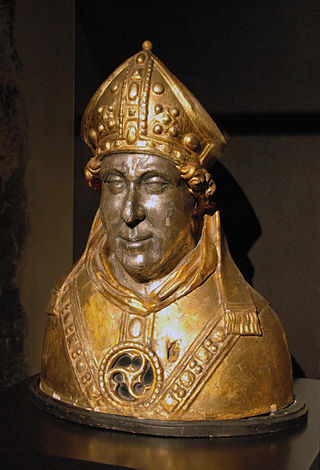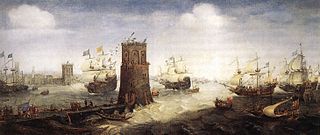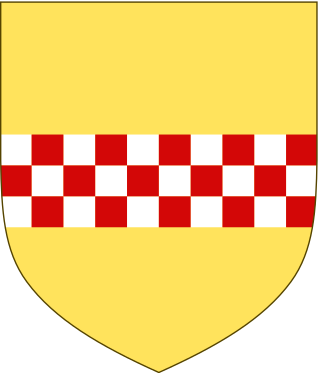Related Research Articles

Henry the Lion was a member of the Welf dynasty who ruled as the duke of Saxony as Henry III and Bavaria as Henry XII from 1142 and 1156, respectively, until 1180.

Count Engelbert II of Berg, also known as Saint Engelbert, Engelbert of Cologne, Engelbert I, Archbishop of Cologne or Engelbert I of Berg, Archbishop of Cologne was archbishop of Cologne and a saint; he was notoriously murdered by a member of his own family.

Burg Castle, located in Burg an der Wupper (Solingen), is the largest reconstructed castle in North Rhine-Westphalia, Germany and a popular tourist attraction. Its early history is closely connected to the rise of the Duchy of Berg.

Henry V, the Elder of Brunswick, a member of the House of Welf, was Count Palatine of the Rhine from 1195 until 1212.

Henry IV was the duke of Limburg and count of Berg from 1226 to his death. He was the son of Waleran III, count of Luxembourg and duke of Limburg, and Cunigunda, daughter of Frederick I, Duke of Lorraine.
Adolf III of Berg was count of Berg from 1093 until 1132, and count of Hövel from 1090 until 1106, and Vogt of Werden. He was the son of Adolf II of Berg-Hövel, count of Berg, and Adelaide of Lauffen.

Adolf IV of Berg count of Berg from 1132 until 1160 and of Altena, son of Adolf III of Berg count of Berg and Hövel. He married (1st) Adelheid von Arnsberg, a daughter of Heinrich count von Rietberg; then (2nd) Irmgard (?) von Schwarzenberg, a daughter of Engelbert von Schwarzenberg.

Count Adolf VI of Berg ruled the County of Berg from 1197 until 1218.

Adolf II of Berg-Hövel (Huvili), count of Berg, count in Auelgau and Siegburg, Vogt of Werden, was the son of Adolf I of Berg.

Adolf I, Count de la Mark, until 1226 also known as Adolf I, Count of Altena-Mark. He was son of Frederick I, Count of Berg-Altena and Alveradis of Krickenbeck, daughter of Reiner of Krieckenbeck-Millendonk.

Adolf I of Berg, count of Berg from 1077 until 1082, Vogt of Werden, Deutz, Berg and Gerresheim. He was the son of Adolf II of Lotharingia count of Keldachgau, Vogt of Deutz (1002–1041).

The House of La Marck was a noble family, which from about 1200 appeared as the counts of Mark.
Friedrich II of Berg, was Archbishop of Cologne from 1156 until his death in 1158.

Berthold IV, a member of the House of Andechs, was Margrave of Istria and Carniola. By about 1180/82 he assumed the title of Duke of Merania, referring to the Adriatic seacoast of Kvarner which his ancestors had conquered in the 1060s and annexed to Istria and Carniola.

The House of Limburg-Stirum, which adopted its name in the 12th century from the immediate county of Limburg an der Lenne in what is now Germany, is one of the oldest families in Europe. It is the eldest and only surviving branch of the House of Berg, which was among the most powerful dynasties in the region of the lower Rhine during the Middle Ages. Some historians link them to an even older dynasty, the Ezzonen, going back to the 9th century.
The Crusade of 1197, also known as the Crusade of Henry VI or the German Crusade, was a crusade launched by the Hohenstaufen emperor Henry VI in response to the aborted attempt of his father, Emperor Frederick I, during the Third Crusade in 1189–90. Thus the military campaign is also known as the "Emperor's Crusade".
Simon I, Count of Tecklenburg was Count of Tecklenburg from 1156 until his death.

Theoderich von Wied was Archbishop and Prince-elector of Trier from 1212 until his death.

The house of Limburg Hohenlimburg took its name in the 12th century from the county of Limburg on the river Lenne in today's Germany. After Diederick of Isenberg had claimed part of the former property of his father Frederik of Isenberg with the help of uncle Duke Hendrik of Limburg, he built the Hohenlimburg castle on the river Lenne. His youngest son Everhart succeeded him in the county at the end of the 13th century and is the ancestor of the family branch of the counts of Limburg Hohenlimburg and Broich. His eldest brother Johan (1247-1277), died at the age of thirty, left three children. The Counts of Limburg Hohenlimburg and Broich were not only a count by name (title), but actually ruled the county of Limburg-Lenne until the first quarter of the 16th century. The last count Johan (1464-1511) who had no descendants of his own. None of his only two male relatives, cousins Diederick and Adolf of Limburg, sons of his former godfather Johan of Limburg (1421-1472), had inheritance rights, as explained below. To prevent the family of his former wife Von Neuenahr from taking the county, Count Johan adopted his cousin Irmgard of Sayn at her marriage to Winrich of Daun. She and her husband inherited the county.